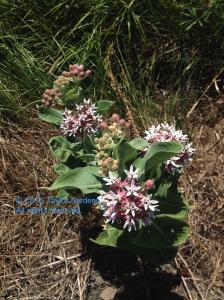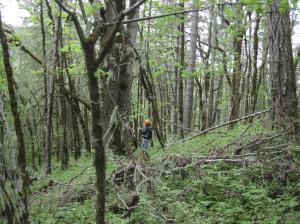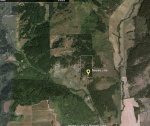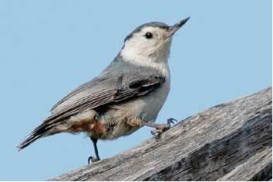In April, NPR ran a story about shooting one species of owl to save another in Oregon. It just begs for commentary.
Although there aren’t any spotted owls on our place, this is an example – no, possibly THE example of the ethics and dilemma of ecological restoration and questions surrounding repair of damaged ecosystems:
- Are the results of human-caused ecosystem change separable from change that occurs naturally?
- If we are serious about saving species and habitat, how far do we have to go to change our own behavior that caused their decline?
- Are we in a downward spiral – making the situation worse by reacting to the effects of our actions rather than addressing the true causes of extinction?
- Is this whole endangered species recovery exercise going to work for some but not all species? Which species will be able to live with us?
- Will that be enough to preserve the safety net we humans depend on to survive?
Okie doke, so in a nutshell here is the situation:
In the 1970’s, a biologist named Eric Forsman did groundbreaking research on the northern spotted owl (Strix occidentalis caurina). Forsman found that spotted owls depend on old-growth forest habitat. It was determined that they were endangered due to loss of old growth to widespread logging in the Pacific Northwest.
In 1990 the northern spotted owl was placed on the endangered species list. The Endangered Species Act (ESA) mandates protection for species if they are listed, plus a plan to bring them back from the brink. So in 1991 millions of acres of federal forestland were excluded from logging to save habitat for the northern spotted owl. All hell broke loose in the logging communities of the Pacific Northwest, because of their dependence on federal timber land. For an excellent account, see The Final Forest by William Dietrich.
So for the last 30+ years Eric Forsman and a lot of other biologists and managers have been working to bring the spotted owl numbers up by saving habitat. But in fact the numbers are sinking.
As early as 1998 reports about an aggressive cousin – the barred owl (Strix varia) – discussed it as a potentially game-changing threat to the spotted owl (The Owl: Spotted, Listed, Barred or Gone?). Now it has come to pass that yes, the barred owl is currently a big factor in the decline of the northern spotted owl. The biggest factor.
Where did barred owls come from? Apparently barred owls started moving west from the eastern US about the time settlers began plowing up the prairies and suppressing fire. They moved through Canada and Montana, and started expanding their range into the Pacific Northwest in the 1960’s. Was it because of us? Or would this have happened anyway? Impossible to say. The two species might have evolved from a common single species at the time of the last ice age – at least we can be reasonably sure humans didn’t have anything to do with that.
Interestingly, barred owl populations here did not explode until about 20 years ago – about the time the spotted owl was listed. Speculation about why this happened follows this line of reasoning: like many invasive species, at first there aren’t many of them, but gradually they become adapted to their surroundings, or perhaps their population builds to the point where they just produce a ton of offspring. Suddenly the population explodes – because they have few or no predators and parasites, or because they are just better at hogging resources.
In the case of the barred owl, not only are they more aggressive, they are omnivorous and voracious. Whereas the spotted owl is more retiring, and picky about what it will eat – which happens to be old growth-dependent species like flying squirrels and tree voles. Spotted owls are part of a wonderfully complex and delicate food web, involving truffles, arboreal mammals, and big tree cavities. Fat lot of good that did them.
Because barred owls scare off spotted owls (although not always – they also hybridise with them, meaning it is possible spotted owl genes could be lost or “swamped” by barred owl genes), and because they aren’t particular about what they eat, they have no problem supporting themselves at the expense of spotted owls. But when barred owls have been removed or shot, spotted owls show up again. This is where the idea of getting rid of the barred owls came from. But really, this is an idea that can’t get very far. If land managers could get past the outcry over shooting a sort-of native bird, according to Eric Forsman, “You could shoot barred owls until you’re blue in the face, but unless you’re willing to do it forever, it’s just not going to work.”
So were all those years of trying to save habitat wasted?
People who depend on timber for income, and who have suffered disproportionately during the recent economic recession are suggesting that okay, since you can’t save the spotted owl by setting aside habitat, it doesn’t matter. Let us start cutting timber in the reserves set aside during the 1990’s. This is the disadvantage to saving species instead of looking at the really big picture – people can argue that if we can’t save those species, we don’t need their habitats. But this would accelerate the degradation of ecosystems we all depend on.
…far from saying that the logging restrictions were a mistake, owl biologists largely insist that more forests must be spared, especially since heavy logging continues on state and private land.. .”If you start cutting habitat for either bird, you just increase competitive pressure.”
http://www.smithsonianmag.com/science-nature/The-Spotted-Owls-New-Nemesis.html#ixzz1ywI7txwy
Besides the barred owl, It appears that other changes in the larger landscape have caught up with efforts to conserve spotted owls. A recent review on spotted owl protection lists wildfire as a major threat to spotted owls in drier areas of the Cascades (remember the Biscuit fire?). That is a result of first, more than a century of fire suppression and second, climate change and normal weather patterns leading to conditions conducive to fire in forests loaded with fuel.
In a landscape before habitat became so scarce, if a fire burned one part of the forest, animals and plants could survive in refugia or recolonize from neighboring undamaged habitat. Now that there is so little intact high quality habitat left and it is fragmented, it is a dangerously fragile situation – organisms may not be able to find a place to wait out a wildfire or there may not be an adjoining area that can donate species to it later. With only 10% of high quality intact ecosystems remaining, on average, in the Northwest (e.g. old growth forest, Willamette Valley prairie and savannah, shrub-steppe in eastern Washington) it’s no wonder things are falling apart.
Lots of species are suffering the effects of practices that began during settlement and development of the west. Saving iconic wild salmon runs has been a priority for decades – at least people like to say it is. But how is spending time and resources shooting sea lions and relocating Caspian terns that eat salmon congregating below dams helping the situation? It’s stopgap emergency action, not a solution.
There are currently 11 dams on the Columbia River; “…32 dams in the land mass drained by the Columbia River system (including other rivers), an area roughly the size of France.” Does this not suggest that all the efforts to plant trees in riparian areas, shoot sea lions, and barge fish around dams is really just window dressing? If we want hydropower and irrigation, large scale agriculture and forestry, we will not have wild salmon.
Salmon and owls are two species that are indicators of a healthy ecosystem. We need to recognize that our ecosystems are at risk, and while it is the job of land managers and biologists to manage species, it requires an effort from all of us to look at the whole and make changes that affect how we build our cities, farm our food, allow ourselves to live with other species.
Many species have learned to live with us – coyotes and crows are two that come to mind. The barred owl can be a member of this club too (they live in suburban and even urban areas). We consider them pests or invasive, and think we have nothing to do with how they came to be so numerous. But they are adapting to us, we facilitated it, and it is in fact all about us. Don’t blame the messenger.
The thing is, if we don’t attend to these problems, we may lose the ecosystems that keep us alive. As with past mass extinctions though, the planet will keep on turning. New combinations of species will appear. Maybe humans will be among them.





























